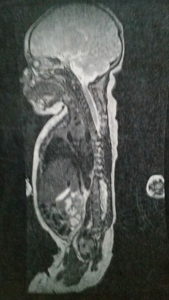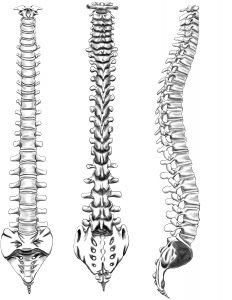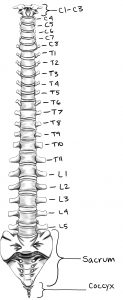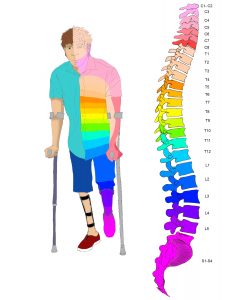
To understand more about SA/CRS, it is important to know some basic information about the spine. Here is a front, back and side view of the spine.

Shown below, the spine is divided into different sections. The highest section, at the neck, are the cervical vertebrae, or “C” for short. There are 8 cervical vertebrae, labeled C 1 through C 8. Below that, between your shoulder blades, are the thoracic vertebrae, or “T” for short. There are 11 thoracic vertebrae, labeled T 1 through T 11. The curve in your lower back is where the lumbar spine are located. There are 5 lumbar vertebrae, labeled L 1 through 5. The sacral vertebrae are at the end, which connects to the pelvis. There are 5 of them but they are not separated like the other vertebrae. They all look like one bone, almost like an arrowhead. The coccyx is the end point of the spine.

The spine is like a tube of bone, and the spinal cord is inside that tube. Nerves from the spinal cord extend out to various parts of the body, and provide signals to and from your body and your brain so that you can move and feel. The image below shows with colors the area of the spine where the spinal cord signals each part of the body.

In SA/CRS, all or part of the sacrum is missing (as well as the coccyx). Sometimes some or all of the lumbar vertebrae are missing too, and sometimes some of the lower to mid thoracic vertebrae are additionally missing. The highest level of spine reported absent among the 1000+ member iSACRA organization is at the 5th thoracic vertebrae. By contrast, some people are only missing a very small portion of the lowest part of the spine, part of the sacrum. Each individual is different. The spinal cord may end at the same point where the spine ends, or above, or below that point. Sometimes the spinal nerves find their own pathways to various parts of the body. Often individuals with SA/CRS are not able to move some parts of their lower legs or feet, but can still feel these parts of their bodies. Sometimes they have increased sensitivity in specific areas of their bodies. The spine and the spinal cord may not end at the same place, and it may have a “blunt” end or a “tapered” end.
If the spine and spinal cord are missing below a specific level, such as L-2, then leg muscles, bowel and bladder function will also be impacted. If the spinal cord is missing below T- 7, then abdominal muscles as well as hips, knees, feet, bowel and bladder will have reduced function.
